May 27, 2017
25G Ethernet was treated as the "new†10GbE technology once it came out in 2014. Similar to 10G Ethernet that was based on 1 x 10Gbps lane scheme, 25GbE physical interface delivers 1 x 25Gbps more data. 25GbE technology with one single lane obviously improves the port density and cost requirement. 25GbE network supports several 25Gbps capable form factors, such as CFP, CFP2, CFP4, SFP28 (1×25 Gbps) and QSFP28 transceiver (4×25 Gbps), which is also used for 100GbE. Of which 25G SFP28 SFP-25G-SR and SFP-25G-LR are two popular optical transceiver modules on the market, the former supporting up to 100m link length while the latter allows a maximum transmission distance of 10 km. This article will make a brief comparison between 25G SFP-25G-SR & SFP-25G-LR optical transceiver modules, and analyze the utilization in 25G to 100G upgrading.
SFP-25G-SR Overview
SFP-25G-SR is 850nm VCSEL 25Gigabit SFP28 transceiver designed to transmit and receive optical data over 50μm duplex LC multimode optical fiber (MMF). 25G SFP28 SR optics can support up to 70m over parallel OM3 Multimode fiber and 100m over parallel OM4 cable. This 25G SFP transceiver is equipped with Digital Optical Monitoring (DOM) function and can be delivered with different temperature ranges, allowing access to real-time operating parameters.
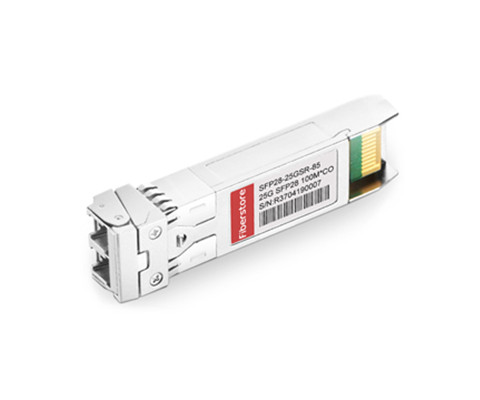
SFP28 SR MMF transceiver optics is comply with current specifications of IEEE 802.3, SFF-8472, SFF-8402, SFF-8432 and SFF-8431. It’s suitable for use with 25GbE Ethernet switches, routers, network interface cards (NICs) and storage networking equipment. The SFP28 SR optics offers the most power efficient way to meet the growing needs of the next-generation data center networking environment.
SFP-25G-LR Outline
SFP28-25G-LR is the SFP28 LR optical transceiver module for 25 Gigabit Ethernet long-reach application. This SFP28 LR optics module features a highly reliable 1310nm DFB transmitter and PIN photo-detector into duplex LC optical connector, providing links up to 10km over single mode fiber (SMF).
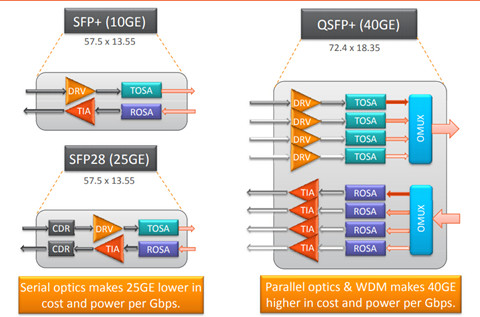
The SFP28 LR SMF transceiver optics is comply with current specifications of IEEE 802.3, SFF-8472, SFF-8402, SFF-8432 and SFF-8431. It’s suitable for use with 25GbE Ethernet switches, routers, network interface cards (NICs) and storage networking equipment. The SFP28 LR optics offers the most power efficient way to meet the growing needs of the next-generation data center networking environment. The above image displays the vivid comparison between 25G SFP28 LR optics and 40G QSFP+ LR4 modules.
SFP-25G-SR & SFP-25G-LR Used in 25G to 100G Data Center Migration
Energy saving and cost are the two important considerations for data center applications. Nowadays 10G Ethernet speed can not meet the demands of increased sever performance, and the 100G relevant devices are too expensive, the appearance of 25G Ethernet standards just made up for the deficiency of them. Compared with 40GbE connectivity, 25GbE requires just one lane (four with 40GbE) but offers superior switch port density, lower costs and power requirements. Therefore, 25GE is good choice as next step after 10GE for SMF and MMF transceivers.
SFP-25G-SR and SFP-25G-LR are the single-channel, pluggable, fiber-optic SFP28 modules for 25 Gigabit Ethernet and Infiniband EDR applications, with low power dissipation 1W.
- 100G to 25G MMF Short-reach Connection
As the following image shows, MTP12 to 4xLC MMF fiber breakout cables are needed to connect between 100G QSFP-100G-SR4 and 25G SFP-25G-SR. This connection types can support up to 100m.
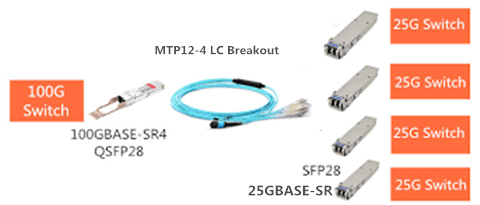
- 100G to 25G SMF Long-reach Connection
As the table 2 shows, SFP28 SFP-25G-LR connects with QSFP28 QSFP-100G-PSM4 over the MTP12 to 4xLC SMF fiber breakout cable. The whole setup can support up to 500m over parallel single mode fiber.

Conclusion
With the rapid development of Internet, cloud computing and big data in recent years, the construction of IT infrastructure data center has been accelerated. A new round of updating is underway for the Ethernet including 25GbE, 40GbE, 50GbE, of them 25G Ethernet is favored. 25G SFP-25G-SR and SFP-25G-LR SFP28 optical transceivers provide smooth and cost-effective solution to 100G networks. FS.COM offers several 25G SFP28 optics to meet your demand. If you are interested, you can have a look at it.
Posted by: fernxu123 at
02:54 AM
| Comments (2)
| Add Comment
Post contains 672 words, total size 6 kb.
May 12, 2017
With the price of 100G optics cutting down, 2017 witnesses the great expansion of `100G hardware market. QSFP28 and CFP 100G optical transceivers are becoming popular among customers. Not only Cisco, HPE, Brocade, and Huawei, but the third party vendors like FS.COM offer 100G devices including the 100G switches, MTP/MPO cables, QSFP28, CFP/CFP2/CFP4 and so on. In this blog, I will compare 100G QSFP28 SR4 with CFP SR10 modules, and analyze the electrical and optical diagram.
CFP 100GBASE-SR10 Module Outlook
CFP 100GBASE-SR10 is a MSA specified 100G C-form factor supporting link lengths of 100 m/150 m over laser-optimized OM3/OM4 cable, respectively. It is mainly used in 10 x 10 Gigabit Ethernet mode along with MTP Harness cables for connectivity to 10 10GBASE-SR optical interfaces. It usually enables high-bandwidth 100Gbps links over 24-fiber MPO/MTP ribbon cables.
100G QSFP28 100GBASE-SR4 Outlook
QSFP28 100GBASE-SR4 module is a parallel 100G optics designed with optical/electrical connection and digital diagnostic interface. It offers 4 independent transmit and receive channels, each capable of 25Gbps operation for an aggregated data rate of 100Gbps for 100m on 12-fiber MPO/MTP OM4 fiber cable. Figure 1 shows the CFP SR10 (left) and QSFP28 modules (right).
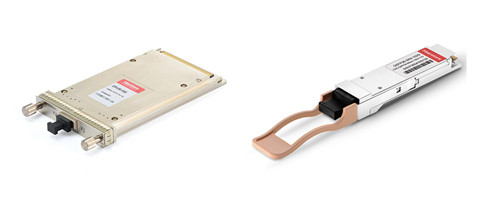
The QSFP28 SR4 transceiver (such as Cisco 100G-QSFP28-SR4) is compatible with 100G QSFP 100GBASE-SR4 standards that meets IEEE 802.3 and MSA requirements with power dissipation well under 3.5W. It supports both 100GBASE-SR4 as well as 4x25G breakout, 100G QSFP28 to QSFP28 DAC and 100G QSFP28 SR4 to 4SFP28 break-out cables.
Comparison Between CFP 100GBASE-SR10 and 100G QSFP28 100GBASE-SR4
- Size Comparison
CFP module is the old generation 100G transceivers. It is designed after SFP modules, but quite larger to support 100Gbps in 10 x 10Gbps lanes. QSFP28 is the newly released 100G form factor, which further increase port density and reduce footprint & power consumption. QSFP28 100GBASE-SR4 has the same form factor as the 40G QSFP optics, supporting 4x25Gbps mode.
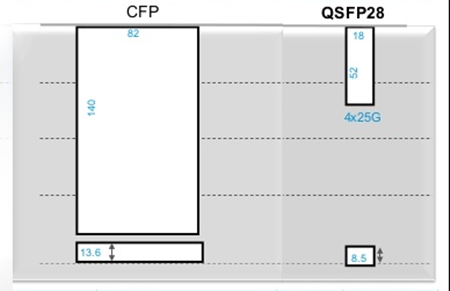
The above image shows the size comparison between CFP 100GBASE-SR10 and 100GBASE SR4 QSFP transceiver. Obviously, QSFP28 is much smaller than CFP 100G modules, which just in time explains the reason that QSFP28 optics is more popular than CFP transceivers.
- Working Principle
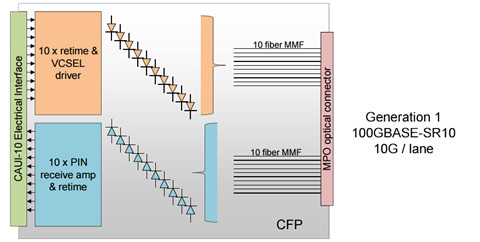

100GBASE-SR4 supports higher speed per channel (25Gbps) than 100GBASE-SR10 (10Gbps), so that QSFP28 can reduce port density with compact footprint.
- Terminating Cables—12F Vs. 24F MTP/MPO MMF
Both CFP 100GBASE-SR10 and 100G QSFP28 100GBASE-SR4 terminates with MTP/MPO OM3/OM4 cables for 100G transmission. However, QSFP28 100GBASE-SR4 modules uses a 12 fibers MPO/MTP multimode cable for connectivity (4 Tx and 4 Rx, each lane providing 25 Gbps of throughput) while CFP 100GBASE-SR10 optics use a 2×12-fiber or 24-fiber strand MPO/MTP multimode cable for connectivity (10 Tx and 10 Rx, each lane providing 10 Gbps of throughput).
CFP 100GBASE-SR10, compared with QSFP28 SR4 optics uses two 12-fiber or one 24-fiber MPO/MTP cable. It is not a cost-effective solution in terms of the cable management.
Conclusion
100GBASE-SR10 CFP and 100GBASE-SR4 QSFP28 are the 100G multimode optics. QSFP28 SR4 transceivers, like 40GBASE-SR4, use a 12 fiber MPO cable with 4 strands for transmit and 4 for receive. While CFP 100GBase-SR10 optics uses a 24 strand MPO cable: 10 strands for transmit and 10 strands for receive. From the above article, we know that 100GBase-SR4 QSFP28 is more cost-effective than 100GBase-SR10 CFP in port density and cable management. FS.COM QSFP28 SR4 is offered at $269 with free shipping to USA, Mexico and Australia. Our reliable 100G CFP modules are also with high quality and low price. If you have any interest, don’t forget to contact us.
Posted by: fernxu123 at
02:37 AM
| No Comments
| Add Comment
Post contains 607 words, total size 6 kb.
May 09, 2017
Today’s technology presents unprecedented migration incorporating a wide range of application requirements such as database, transaction processing, data warehousing, integrated audio/video, real-time computing, and collaborative projects. Fibre Channel and Gigabit Ethernet, both are the ideal solutions for IT professionals who need reliable, cost-effective information storage and delivery at fast speeds. Fibre Channel is available in 1G/2G/4G/8G/16G FC and 10GFCoE, 40GFCoE and 100GFCoE nowadays. Gigabit Ethernet is the reigning network for data center and server room. The battle between Fibre Channel and Ethernet is complicated. However, this article will help you solve it out by comparing 10G SFP+ Fibre Channel transceiver modules and 10G Ethernet SFP+ modules.
Any time we’re transmitting or storing data, we encode it in some form or another. Then we need to understand the encoding mechanisms of Ethernet and FC.
1, 2, 4, and 8 Gb Fibre Channel all use 8b/10b encoding. Meaning, 8 bits of data gets encoded into 10 bits of transmitted information, the two bits are used for data integrity. For example, Original 1Gb FC is actually 1.0625Gb/s, and each generation has kept this standard and multiplied it. 8Gb FC would be 8×1.0625, or actual bandwidth of 8.5Gb/s. 8.5*.80 = 6.8. 6.8Gb of usable bandwidth on an 8Gb FC link.
10GE (and 10G FC, for that matter) uses 64b/66b encoding. For a 10Gb link using 64b/66b encoding, that leaves 96.96% of the bandwidth for user data, or 9.7Gb/s.
10G SFP+ Fibre Channel (FC) transceiver, as the name implies, is the 10G optical transceivers used for Fibre Channel applications. 10G FC SFP+ module has the same footprint as SFP form factor and is compliant with MSA SFF-8431. 10G SFP+ Fibre Channel transceivers uses the either the 850nm VCSEL as the transmitter fro multimode fiber or 1310nm/1550nm laser as the transmitters for single-mode fibers in SONET OC-192 /SDH, 10GBASE-SW, 10GBASE-LW, 10GBASE-EW, and 10GBASE-ZW applications.
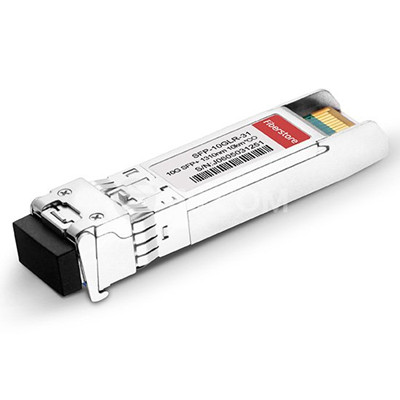
Cisco DS-SFP-FC10G-LW, seen in the above image, is the long-range single-mode 10G SFP+ FC optical module for a link length of 10km over 1310nm wavelength. 10GFC is backward compatible with previous generation 8G/4G/2GFC and will auto-negotiate down to the fastest speed supported by both ports. This allows 10GFC devices and switches to be seamlessly integrated into expansion segments of existing FC networks without a forklift upgrade.
SFP+ 10G modules is the optical transceiver for serial optical communication applications at 10Gbps. Unlike the SFP+ FC transceivers, 10GBASE SFP+ Ethernet modules can use either copper or fiber cabling. SFP+ 10GBASE-T optical transceiver supports Cat6 RJ45 copper cables for a link length of 30m. 10GBASE SFP+ Ethernet modules are available in several 10 Gigabit Ethernet standards like 10GBASE-SR Ethernet, 10GBASE-LR, 10GBASE-LRM, 10GBASE-ER, 10GBASE-ZR, and 10GBASE-T.
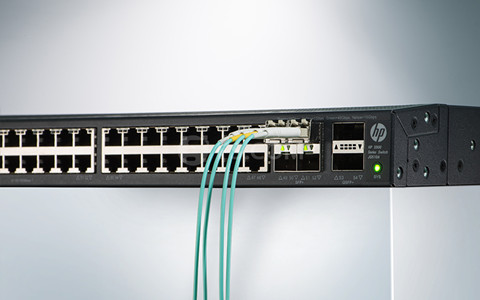 Cisco SFP-10G-LR is the 10km Cisco 10GBASE-LR SFP+ module that uses 1310nm as the transmitter type over single-mode fiber cables. 10GBASE-LR SFP+ modules cannot be auto-negotiate with 1000BASE SFP transceivers, but for most switches, SFP+ ports can support 1G SFP modules for 1Gbps data rate.
Cisco SFP-10G-LR is the 10km Cisco 10GBASE-LR SFP+ module that uses 1310nm as the transmitter type over single-mode fiber cables. 10GBASE-LR SFP+ modules cannot be auto-negotiate with 1000BASE SFP transceivers, but for most switches, SFP+ ports can support 1G SFP modules for 1Gbps data rate.
From the previous description, we can easily draw a conclusion that 10G Fiber Channel SFP+ and 10G Ethernet SFP+ share several specification in common.
- Footprint
- Performance
Except the application, 10G Fiber Channel SFP+ SW module and 10Gb SR SFP+ transceivers have the very similar functions with each other. For the exact information, please see the following table.

- Application
10G Fiber Channel SFP+ is used in 10G Fibre Channel, yet 10G Ethernet SFP+ is utilized in 10G Ethernet networks.
Without denying, Ethernet is the dominating network for every data center and server room. The "old†Ethernet network—1Gb/s and 10Gb/s speeds relied heavily on TCP to deliver data, which was reliable but somewhat unpredictable. However, today’s Ethernet runs at 25, 40, 50, or 100Gb/s speeds, is no longer dependent on TCP alone. It also supports RDMA connections which lower latency and frees up CPU cycles to run applications. 100Gb/s technology is quite matured in 2017 and there are many relevant devices available on the market, such as CFP/QSFP28 optical transceivers, 100G switches and network interface cards, 24 fiber MTP cables, etc.
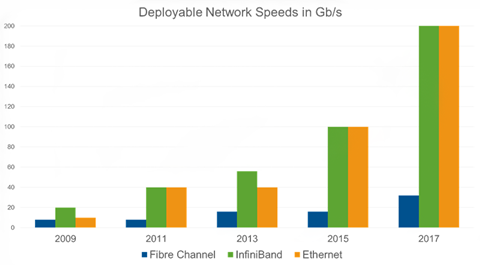
Meanwhile, FC is still transitioning to 16/32 Gb/s technology (32Gb/s is not mature), which is quite slower than what Ethernet was supporting several years ago. For 32Gb/s FC network, it still supports only block storage traffic. Other storage (and other non-storage) traffic will require an Ethernet network anyway.
If we look at what is coming in 2017, the battle will not be 10/40/100GbE Vs. 8/10/16/32Gb FC. Almost everyone would agree that it would be nice to have a single network for all traffic, and very few users want a new protocol and the challenges of changing the way that they do things.
FC or Ethernet, which is best for storage? 10Gb FC SFP+ has the same usable bandwidth as the 10Gb Ethernet SFP+, and without the overhead of FCoE, but you don’t get the consolidation benefits of using the same physical link for your storage and traditional Ethernet traffic. FS.COM offers reliable 10G SFP+ transceivers in Ethernet, FC, BiDi, CWDM/DWDM applications. If you are interested in our products, please contact us directly.
Posted by: fernxu123 at
08:50 AM
| Comments (1)
| Add Comment
Post contains 890 words, total size 8 kb.
35 queries taking 0.3808 seconds, 84 records returned.
Powered by Minx 1.1.6c-pink.









